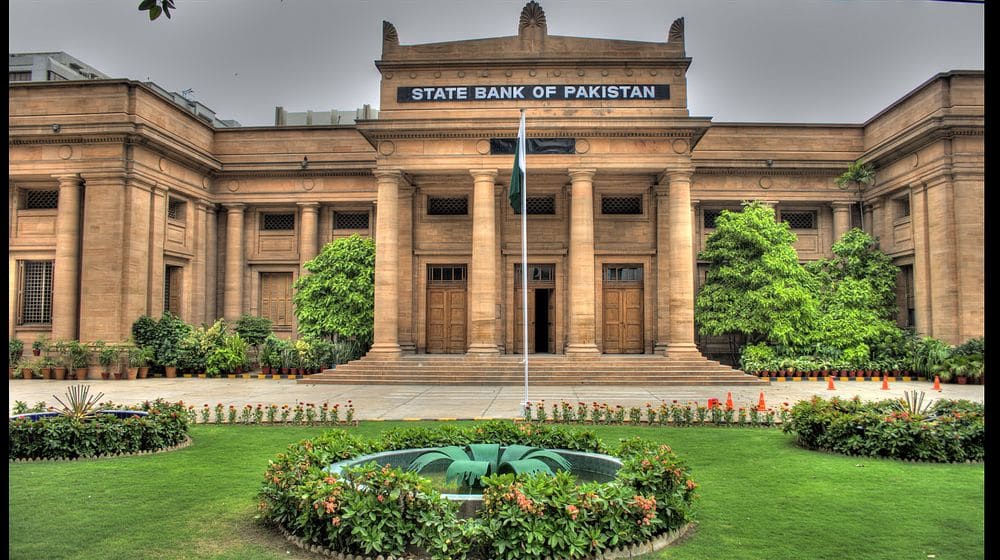The State Bank of Pakistan (SBP) has decided to keep the policy rate unchanged at 7 percent.
This was revealed by the central bank in a statement issued today about the new monetary policy as approved by the Monetary Policy Committee (MPC), in its meeting held on May 28, 2021. The central bank has kept the interest rate unchanged at 7% for the fifth time.
1/3 MPC has decided to maintain policy rate at 7%. While inflation has risen since January, a small number of energy and food items account for about 3/4 of this rise. Demand-side pressures are contained, wage growth is subdued and inflation expectations are reasonably anchored.
— SBP (@StateBank_Pak) May 28, 2021
Since its last meeting in March, the MPC was encouraged by the further upward revision in the FY21 growth forecast to 3.94 percent. The MPC noted that this confirms the strength of the broad-based economic rebound underway since the start of the fiscal year, on the back of targeted fiscal measures and aggressive monetary stimulus. This positive momentum is expected to persist, translating into higher growth next year.
A.A.H Soomro, Managing Director at Khadim Ali Shah Bukhari Securities, told Propakistani,
The policy rate continues to favor growth & is appropriate in wake of current account comfort, FX reserves and the economic output gap. The forward guidance so far implies no change in the next policy as well. However, trade deficit is worsening. It would have to be considered at an eventual stage. So far dollars are aplenty. Growth at all costs.
According to the statement issued by the SBP, inflation rose to 11.1 percent (y/y) in April, propped up by the lingering impact of this February’s electricity tariff increase as well as a pick-up in month-on-month food prices, partly driven by the usual seasonality around Ramzan.
The MPC noted that supply-shocks to food and energy still dominate, with a small number of energy and food items in the CPI basket accounting for about three-fourths of the rise in inflation since January. The MPC also observed that although core inflation in urban areas has risen by around 1.5 percentage points during this period, available evidence suggests that demand-side pressures on inflation continue to be relatively contained.
This reflects the fact that despite the economic recovery, there is still some spare capacity following last year’s contraction. Second-round effects from the supply shocks are also not visibly apparent: price pressures are concentrated in a few items, wage growth is subdued keeping a cap on costs, and inflation expectations remain reasonably anchored.
As previously forecast, the headline year-on-year inflation rate is likely to remain elevated in the coming months due to the recent electricity tariff hike, pushing the average for FY21 close to the upper end of the announced range of 7-9 percent. As supply shocks dissipate thereafter, inflation is expected to gradually fall toward the 5-7 percent target range over the medium term.
Real sector
The latest National Income Accounts data confirm that the economy has rebounded strongly from last year’s severe Covid-shock, led by services and industry. The industrial sector is estimated to have grown 3.6 percent during FY21, driven by construction and large-scale manufacturing, especially the food, cement, textile and automobile sectors.
The strong rebound is also reflected in exceptionally strong growth recorded in multiple high-frequency indicators across all three quarters of the year, including sales of fast-moving consumer goods and POL products. The agriculture sector is estimated to have grown 2.8 percent, with the production of three important crops―wheat, rice and maize―rising to record highs and that of sugar cane to its second-highest ever level.
Buoyed by the strong performance in commodity-producing sectors, services are estimated to have rebounded from last year’s contraction to register a growth of 4.4 percent, led by wholesale and retail trade, added the SBP.
External sector
The MPC noted that, unlike several previous growth upturns in Pakistan, the current economic recovery has been achieved without compromising external stability. At $0.8 billion, the current account has remained in surplus through the first ten months of FY21 for the first time in 17 years. In recent months, imports have picked up with the economic recovery, rising international commodity prices, as well as one-off shipments of wheat and sugar to quell temporary domestic shortages. However, this is being largely offset by record remittances, which rose to all-time highs in April on both a monthly ($2.8 billion) and cumulative basis ($24.2 billion).
In addition, exports have grown by almost 14 percent (y/y) so far this year, mainly due to high-value-added textiles and favorable prices. In March, Pakistan successfully completed the combined 2nd-5th reviews of the IMF program and returned to international capital markets by raising $2.5 billion through an over-subscribed Eurobond, issued at yields below the initial price guidance.
Together, these positive external developments kept the PKR broadly stable since the last MPC meeting around its pre-Covid level and saw SBP’s foreign exchange reserves rise to almost $16 billion, a four-year high, read the statement.
“Looking ahead, the current account deficit is expected to remain bounded, modulated by the flexible exchange rate regime, and external financing needs should be comfortably met, further bolstering foreign exchange buffers,” it added.
Fiscal sector
As envisaged in this year’s budget, fiscal consolidation has progressed well through the first three-quarters of FY21. At 3.5 percent of GDP, the fiscal deficit is 0.6 percentage points lower than last year, despite higher interest payments and Covid-related expenses. Led by a rebound in sales tax and direct taxes, FBR tax collection (net of refunds) has increased by 14 percent.
Restrictions on supplementary grants and austerity measures have contained non-interest current expenditures, which grew by 6.7 percent, only around half the rate of last year. As a result, the primary balance recorded a 1 percent of GDP surplus, its highest level through the first three quarters in 12 years.
Monetary and inflation outlook
The MPC noted that financial conditions remain appropriately accommodative. Since the last meeting, market yields have declined in line with the forward guidance provided by the MPC and private sector credit has witnessed a notable uptick, consistent with previous growth upturns. Cumulatively through April, the flow of private sector credit has grown by 43 percent (y/y), led by fixed investment and consumer loans, primarily due to the low-interest rate environment and SBP’s refinancing schemes, especially TERF and LTFF.
Inflation rose to 11.1 percent (y/y) in April, propped up by the lingering impact of this February’s electricity tariff increase as well as a pick-up in month-on-month food prices, partly driven by the usual seasonality around Ramzan.
As previously forecast, the headline year-on-year inflation rate is likely to remain elevated in the coming months due to the recent electricity tariff hike, pushing the average for FY21 close to the upper end of the announced range of 7-9 percent. As supply shocks dissipate thereafter, inflation is expected to gradually fall toward the 5-7 percent target range over the medium term, read the statement.
Future Outlook
Looking ahead, in the absence of unforeseen circumstances, the MPC expects monetary policy to remain accommodative in the near term, and any adjustments in the policy rate to be measured and gradual to achieve mildly positive real interest rates over time.
If demand-side pressures emerge as the recovery becomes more durable and the economy returns to full capacity, the MPC noted that it would be prudent for monetary policy to begin to normalize through a gradual reduction in the degree of accommodation.
“This would help ensure that inflation does not become entrenched at a high level and financial conditions remain orderly, thereby supporting sustainable growth,” it added.

























